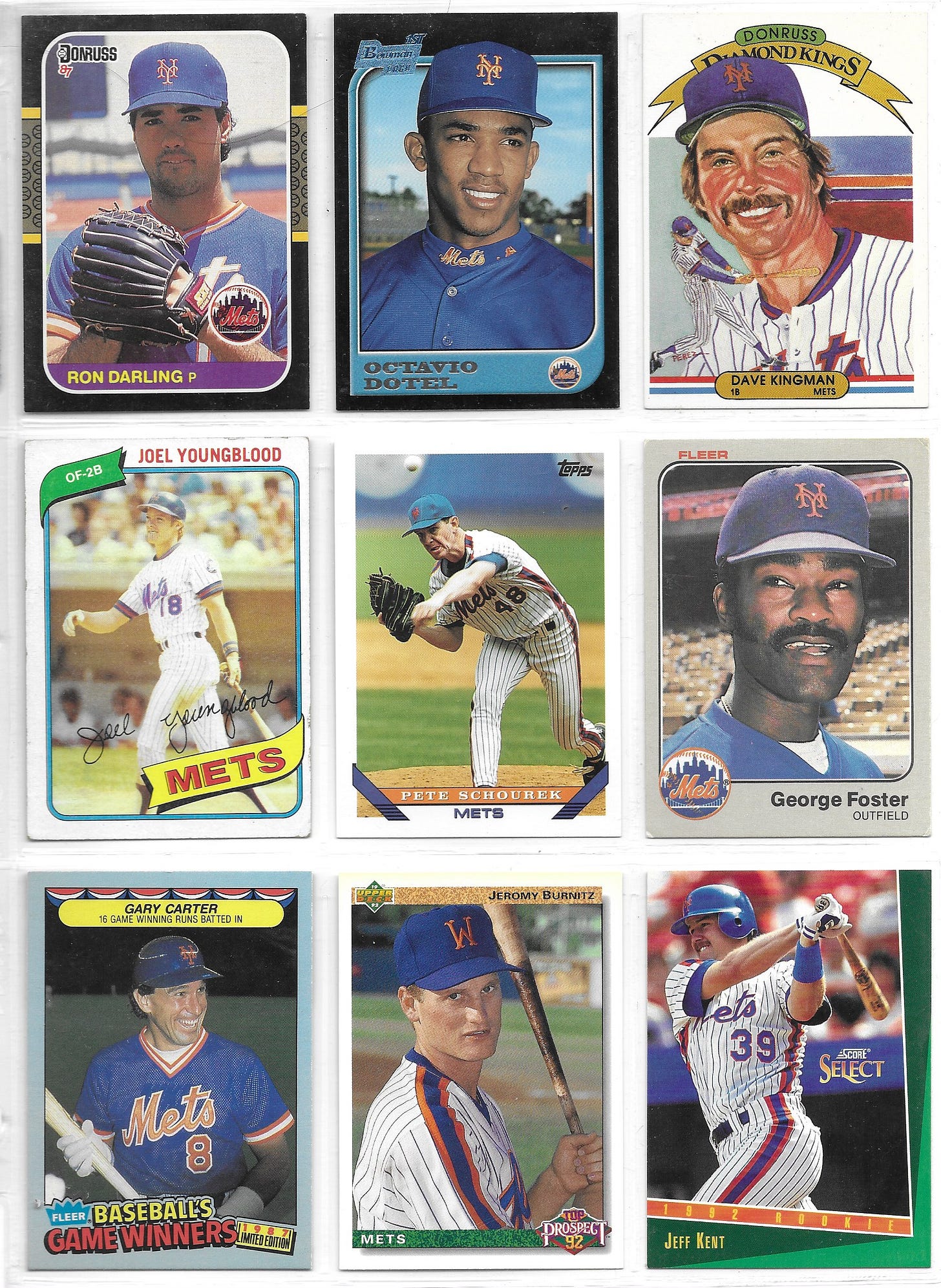Oops, All Mets!
An Immaculate Grid turned orange and blue, with a hint of bleu, blanc, et rouge
Since Addy brought up the newsletter on the podcast, I figured I ought to write something. I’ve been struggling with what parameters to set for an Immaculate Grid-based series since the initial post, and all I’ve really been doing is filling a binder with each day’s puzzle, plus some others along the way. I realize that there don’t have to be rules: this is a space that I set up and I can do what I want here. So, I did an Immaculate Grid, yesterday’s puzzle, No. 534, and filled it out with only Mets from my baseball card collection. The full grid has a rarity score of 28.
Aside from all being Mets, is there anything that ties these trios together? You bet.
Ron Darling (2% rarity score), Octavio Dotel (3%), and Dave Kingman (2%) not only all were Oakland A’s, but all had a season where they played for at least three teams: Darling in 1991 (Mets, Expos, A’s), Dotel in 2010 (Pirates, Dodgers, Rockies), and Kingman in 1977 (Mets, Padres, Angels, Yankees).
The row of Reds does not make a compelling trio. Joel Youngblood (0.9%) and Pete Schourek (0.1%) both were second-round draft picks out of Texas high schools, but George Foster (13%) wasn’t: the Giants selected him out of El Camino College in Caliofrnia in the third round of the 1968 January phase. Foster was teammates with Youngblood on the 1976 Reds and 1982 Mets, in each case not for long because Youngblood got traded. After his rookie year, the Reds traded Youngblood to St. Louis for Bill Caudill at the end of 1977 spring training; the Mets famously dealt him to Montreal in 1982 and Youngblood became the only player to play for two different teams in two different cities on the same day.
What ties together Schourek and Foster is that each made his Mets debut in a win over the Phillies, and Hubie Brooks scored for the Mets in each of those games. What’s remarkable about that is that in between those 1982 and 1991 games, Brooks was traded to the Expos, signed as a free agent with the Dodgers, and traded back to the Mets for Bobby Ojeda.
When the Mets traded Brooks to the Expos, it was the deal for Gary Carter (7%), who along with Jeromy Burnitz (0.7%) and Jeff Kent (0.3%) not only all hit 300-plus career home runs, but also played for the Dodgers.
Carter’s last swing at Shea Stadium, back with the Expos in his 1992 farewell season, resulted in a ground ball to Kent, starting a 4-6-3 double play. The next season, Burnitz joined the Mets, a first-round draft pick in 1990 who rocketed through the farm system.
After two seasons, Burnitz was dealt to Cleveland with Joe Roa for Paul Byrd, Jerry Dipoto, and Dave Mlicki. Kent followed in the summer of 1996, sent to Ohio with José Vizcaino for Carlos Baerga and Álvaro Espinoza, who was somehow still in the league. But the Burnitz-Kent reunion didn’t last, as Burnitz was traded for Kevin Seitzer at the old August trade deadline.
On the columns, the three on the left all were All-Stars as Mets: Darling in 1985, Youngblood in 1981, Carter from 1985-88 consecutively.
In the middle, Burnitz homered off Dotel in 2003, and was 2-for-8 against him overall, while he went 1-for-8 against Schourek. In none of those 16 at-bats was Dotel, Schourek, or Burnitz a Met, although both Dotel and Schourek did pitch as Astros to Burnitz — they were not themselves teammates on the Astros.
The trio on the right all played for the Giants: Kingman from 1971-74, Foster from 1969-71, and Kent from 1997-2002. Kingman and Foster were teammates for two years in New York, but unlike Kent and Burnitz with Cleveland in 1996, their time with the 1971 Giants didn’t overlap. Foster was traded to Cincinnati on May 29 for Frank Duffy and Vern Geishert, and Kingman made his major league debut on July 30 as a pinch-runner for Willie McCovey. As teammates, Foster and Kingman scored the only runs in Tom Seaver’s homecoming at Shea in 1983 (Seaver got a no-decision after throwing six scoreless innings).


